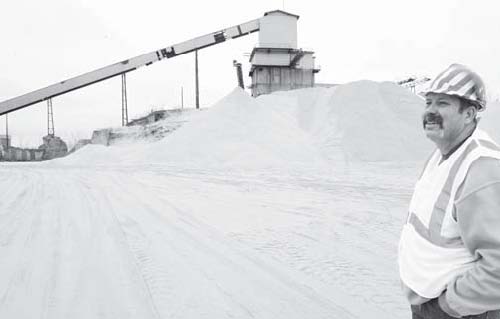Sand Storms In Sales


R.W. Sidley Co. owner Rob Sidley stands in front of a pile of crushed, rare conglomerate silica sand that can be processed into a wide variety of products including silica sand used to frack wells.
Associated Press
AKRON
The boom in drilling for natural gas trapped in layers of shale has been good news for a handful of Ohio companies that supply the type of sand needed for such drilling.
Rob Sidley’s family-owned company in Thompson in Northeast Ohio processes sand that is perfect for the drilling process because it’s nearly 100 percent quartz as well as round, hard and water resistant. It flows like liquid and can survive heavy pressures underground.
The Akron Beacon Journal reports that companies such as Sidley’s have a valuable commodity since 6,000 to 8,000 tons of sand are needed to drill one well. A decade ago, such sand sold for about $35 a ton, compared with $60 to $80 a ton today.
The process for releasing gas in the Marcellus and Utica shale formations blasts thousands of gallons of sand- and chemical-laced water into the shale, a process known as hydraulic fracturing or fracking.
“It’s all about Mother Nature and location,” said Sidley. “We just have what we have. And we love what we have. It’s something special.”
Ohio issued dozens of Utica and Marcellus drilling permits this year, compared to only a handful just a couple of years ago.
Sidley’s firm supplies his sand to well-service companies that in turn provide it to companies such as Oklahoma-based Chesapeake Energy Corp., the biggest driller in Ohio.
Sidley declined to reveal how much fracking sand his company is expecting to produce, but the company annually produces 400,000 to 500,000 tons of sand and gravel from its 1,800-acre operation with 150 employees.
The drilling industry says fracking has been used safely for years, while opponents worry about the possible effect on the environment.
Sidley’s business is one of a handful of sand-and-gravel operations in Ohio that produces suitable sand for fracturing, the Ohio Department of Natural Resources says.
Sands suitable for fracking are found only in three counties, Geauga in Northeast Ohio, Knox in eastern Ohio and Ross in Southern Ohio, said Patrick Jacomet, executive director of the Gahanna-based Ohio Aggregates & Industrial Minerals Association.
Most Ohio sands are too soft, the wrong shape or too prone to react with water and chemicals, he said.
The market for fracking sands quadrupled from 2000 to 2009, according to the U.S. Geological Survey. It said drillers used 6.5 million metric tons of sands in 2009, and that total doubled in 2010. A metric ton is 2,204 pounds.
 43
43
